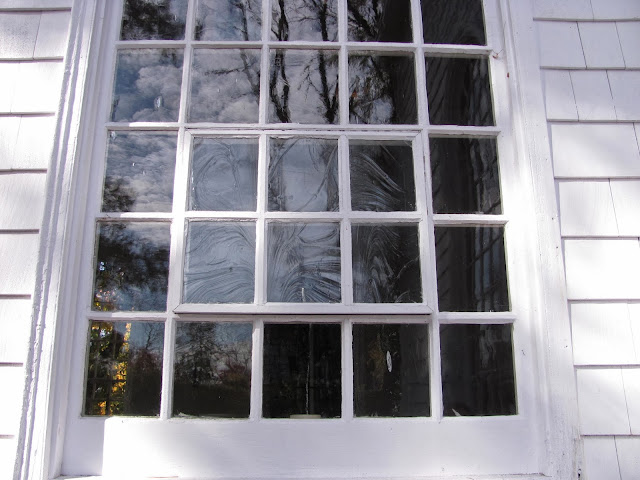
The church building was closed, but I got a glimpse of it through the rippled glass in the arched windows. It looks lovely inside, with the trees on both sides, and the sunlight that streams right through the building.

We took some pictures of the foundation of the building. These appear to be large granite stones mortared in place. While the stones may be original, it's possible that the mortar was added later to give more stability to the structure. St. John's was built about halfway between our two churches (37 years after St. George's was built and 53 years before St. Mark's was built).

The rippled glass looks old, but I'm not sure it's original. The 1840s addition also has rippled glass, which leads me to believe that all of the glass is mid-nineteenth century.

St. John's also has a beautiful little graveyard with gravestones dating from the late eighteenth to the twentieth centuries, along with some memorials and a columbarium from the twentieth and twenty-first centuries.
The stone sculpture on this monument seemed unusually well preserved considering that it's made of marble. We have similar urns in our cemetery, but none of them show this level of plasticity and modeling in their carving.
Does the rock above look familiar to anyone? Meet Groovy Rock's cousin, which is part of the wall in front of St. John's. These shaped granite blocks were quite different from the old dry stone wall that ran along the side of the church, and I'm inclined to think that they are a later addition.

From the building to the cemetery to its surroundings, St. John's Church is probably one of the more beautiful eighteenth/nineteenth century churches I have seen. Unfortunately this style of "country church" seems to have fallen out of favor beginning in the mid-nineteenth century. St. Mark's may have been one of the last of that type in this area. Afterwards, dramatic Gothic buildings with soaring spires, like the nearby Methodist Church, became the norm.





It must have been the mid 19thC or thereabouts which marked the transition in Britain from the simple, organised elegance of Neo Classical to the more lurid excesses of Gothic Revival. I like them both, but they each represent a totally different personal mindset and cultural proclivity, so I wonder why the country as a whole changed from one to the other. Was the change driven by the architects, the national mood, or something else?
ReplyDeleteI think the Gothic Revival was the architectural manifestation of Romanticism. People were shocked by the new modern world created by the Industrial Revolution, and so they looked back to an earlier, seemingly better time, represented in architecture by the Gothic cathedral. The Gothic buildings in New York were inspired by English ones - such as Trinity Church in Manhattan, which I believe is almost an exact replica of some English architect's style. The Gothic style then trickled down into the vernacular architecture of the surrounding areas, so that in the country you get smaller, wooden versions of the great stone cathedrals - or in the case of St. Mark's, you add a Gothic steeple to the existing building because you can't afford to build a whole new church.
ReplyDeleteNot everyone bought into the Gothic styles. Our Quaker Meeting House stayed the same as it had been since the mid-eighteenth century. Interestingly, the Shakers at Mount Lebanon added all sorts of fancy Gothic trimmings to their buildings - trimmings that were promptly removed when the site was converted into a museum in order to restore the buildings to their plain, "Shaker-like" appearance.
Mmm, makes sense I suppose. The reason I posed the question was because I expected you to be savvy in such matters, and I thought it would be easier and quicker than wading through some dreadfully written Wiki article. Thank you.
ReplyDeleteOur Non-Conformists never bought into Gothic either. Part of their ethos was to eschew anything fancy, of course. Their country chapels are small, unassuming red brick buildings, and have been mostly converted into private dwellings now. We have two on the village – a Methodist and a Primitive Methodist – and I must say they make rather characterful dwellings.
By the way, you seem to know just how much to put into a picture to tell the story. No pointless fat.